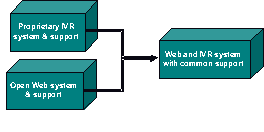Business Advantages of VoiceXML
If you're thinking about investing in proprietary technology or utilizing your existing interactive voice response (IVR) system to voice-enable your web site, think again. If you don't invest in VoiceXML today, the chances are pretty good you'll be porting your investment to VoiceXML in the foreseeable future. Here's why:
- Flexibility. VoiceXML-based applications offer unprecedented flexibility, whether deployment means purchasing equipment, outsourcing via hosting services, or a combination of the two.
- Re-use of Internet infrastructure. Most enterprises today have a web infrastructure and an IVR infrastructure. VoiceXML lets you eliminate separate silos of equipment, maintenance and support.
- Choose best-of-breed. Open VoiceXML solutions allow for the separation of applications, platforms and speech engines so you can select best-of-breed at each layer.
- VoiceXML products are available today. The VoiceXML 1.0 specification was published nearly a year ago, and its promise is being fulfilled. Several vendors are shipping VoiceXML platforms, and a community of more than 350 member companies is actively engaged in the activities of the VoiceXML Forum, proof that VoiceXML is more than just a trend. In addition, according to data published by companies with on-line VoiceXML development tools, there are in total over 10,000 registered VoiceXML developers.
Flexibility
Enterprises have traditionally deployed IVR systems on premises, with hosted systems accounting for less than 10% of the IVR market over the past several years. Because applications are tightly integrated to proprietary IVR systems, enterprises preferred to deploy systems on premises to maintain control over their applications and to integrate them with legacy systems.
In VoiceXML the application is separated from the speech and telephony resources. The application, written in VoiceXML, resides on any web server. The speech resources (speech recognition and text-to-speech) and telephony resources reside on a VoiceXML Gateway Server, which is linked to the web server via an IP network. The web server hosting the VoiceXML application and the VoiceXML Gateway Server can be co-located, or they can be a continent apart communicating via the Internet.

Figure 1: Components of a VoiceXML System
The separation of the application from the telephony resources gives enterprises added flexibility when making purchasing decisions. While it still may be very attractive to put both the application and the VoiceXML Gateway Server on premises, outsourcing to a VoiceXML hosting company can be much more attractive than outsourcing with proprietary systems. In a hosting scenario, the enterprise can locate the VoiceXML application on premises and therefore maintain total control of the application, including updates and changes. A hosting company provides access to a VoiceXML Gateway that executes the application on demand. The enterprise, which avoids incurring a capital cost to deploy on premises, typically pays the hosting company a per-port or a per-minute access fee. This VoiceXML-enabled architecture allows expensive speech and telephony resources to be shared in a way that leverages economies of scale, while at the same time enabling enterprises to maintain control over their IVR applications.
Because applications written in VoiceXML can be portable among platforms (see footnote), enterprises can select or change hosting partners with relative ease. Since VoiceXML Gateways do not require prior "knowledge" of a VoiceXML application-- the application is delivered on demand--it isn't necessary to incur the significant up-front setup costs generally required to host a proprietary IVR system. With VoiceXML applications, the setup can be as simple as pointing the VoiceXML Gateway to the correct URL.
Enterprises gain additional flexibility by deploying a combination of on-premises and hosted VoiceXML. Hosted systems can complement on-premises systems by providing additional capacity during peak periods of demand. Consider an enterprise that runs annual promotions and experiences very high call volumes for only a few weeks at a time. The enterprise can invest in capacity necessary to cover normal call volume, and contract a hosting firm to provide capacity during the peak season. Likewise, if traffic spikes unexpectedly, a hosting firm could provide additional capacity very rapidly because of the minimal setup required to host VoiceXML applications.
Reuse of Internet Infrastructure
Most enterprises today maintain a Web system for customer contact via computer and an IVR system for customer contact via telephone. Each separate system used to mean separate investments, separate programmers needed to write applications, and separate staff to operate and maintain the system. Obviously, this is a very expensive approach.
VoiceXML makes it possible to build telephone services while reusing existing Web infrastructure, and that makes it possible to share and utilize resources in a much more efficient manner. VoiceXML applications reside on web servers where they can be maintained with the same resources used to maintain traditional Web applications. VoiceXML applications can even share the same back-end links to legacy systems and databases that have been developed to support web applications.

Figure 2: VoiceXML--Evolution of a Web Infrastructure
Application development in VoiceXML can leverage the same familiar development tools used by Web developers. Application developers familiar with XML or HTML can learn VoiceXML very rapidly. What is more, the large and rapidly growing community of VoiceXML developers makes it much easier to find application developers familiar with VoiceXML, much more so than it was to find developers familiar with proprietary service creation languages.
Continued...
Footnote: One caveat to be aware of in the area of portability is the fact that the VoiceXML 1.0 Specification does not specify or require support of a particular grammar format. Presumably, this issue will be addressed in the future releases of the VoiceXML specification. (back to article)

back to the top

Copyright © 2001 VoiceXML Forum. All rights reserved.
The VoiceXML Forum is a program of the
IEEE Industry Standards and Technology Organization (IEEE-ISTO).
|

